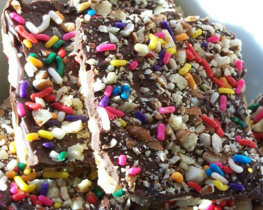MARTHA STEWART is Americas most trusted lifestyle expert and teacher, and the author of more than 80 books on cooking, entertaining, crafts, homekeeping, gardening, weddings, and decorating.
KEVIN SHARKEY, Executive Director of Design at Martha Stewart Living, helped found the decorating and floral-design voice of Martha Stewart Living magazine, working alongside Martha for 22 years.
ACKNOWLEDGMENTS
Many people are to be thanked for their help with this book. Many have never visited my gardens, but they have provided me with many of the plants and seeds and bulbs and shrubs that fill those gardens. They have been instrumental, through their exquisite catalogs and with their superb plant materials, in making my gardens the interesting sources for most everything Kevin and I used in the photographs for this book.
I especially want to thank, in no particular order, the following plantsmen and women: Brent and Beckys, Van Engelen, B&D Lilies, Van Bourgondien Nursery, Johnnys Selected Seeds, Vilmorin, David Austin Roses, Marders, The Bayberry, Landcraft Environments, Broken Arrow Nursery, Glover Perennials, Hardscrabble Farms, Surry Gardens, Burpee, Home Depot, Proven Winners, Annies Annuals & Perennials, Rainbow Iris Farm, Peonys Envy, Klehms Song Sparrow Nursery, Opus, Hillside Nursery, and Old House Gardens.
And a great big thank you to my current gardeners who nurture the plants and tend to my gardens all year long: Ryan McCallister and Wilmer Artiga and the Katonah crew, Alex Silva and his East Hampton crew, and Michael Harding and his Seal Harbor crew. Thanks also to all the fine hands who have cared for all of my gardens in past years.
Kevin Sharkey and I would also like to extend our thanks to our editorial director, Ellen Morrissey; managing editor Susanne Ruppert; senior associate editor Bridget Fitzgerald; Nanette Maxim; the designer of this volume, Mary Jane Callister; and all the photographers and stylists who aided us while flowers were cut, backgrounds were styled, and arrangements created. Thank you as well to Maison Gerard for graciously loaning us the beautiful tulipiere by Matthew Solomon, pictured on .
And thank you to my longtime publisher, Clarkson Potter, for allowing us to make such a lavish, beautiful, useful bookour ninetieth, give or take one or two!
PHOTOGRAPH CREDITS
SANG AN :
CHRISTOPHER BAKER :
EARL CARTER :
JOHN DOLAN : (top center)
PIETER ESTERSOHN :
RICHARD FELBER:
KRISTINE FOLEY :
FORMULA Z/S :
DOUGLAS FRIEDMAN :
DANA GALLAGHER :
BRYAN GARDNER :
GENTL AND HYERS :
GABRIELA HERMAN : (top and bottom right)
LISA HUBBARD :
STEPHEN KENT JOHNSON : (left)
ANDREA JONES : (right)
MIKE KRAUTTER :
FREDERIC LAGRANGE :
KATE MATHIS :
CHELSEA MCNAMARA :
DAVID MEREDITH : (top left)
NGOC MINH NGO :
VICTORIA PEARSON :
JOS PICAYO : (bottom left)
ANNIE SCHLECHTER :
MATTHEW SEPTIMUS :
SETH SMOOT :
ANNA WILLIAMS :
Daffodil
NARCISSUS
ALL DAFFODILSFROM BIG YELLOW TRUMPETS TO TINY ROCK-GARDEN DELICACIES, AND EVERYTHING IN BETWEENHAVE THREE ESSENTIAL CHARACTERISTICS THAT MAKE THEM THE ULTIMATE NO-FUSS PERENNIALS: DEER- AND OTHER PEST-PROOF QUALITIES, THE DESIRE TO BLOOM AND MULTIPLY, AND UNABASHED GOOD CHEER.
In Katonah, an area plagued by rampant deer, I originally planned to protect only small portions of my garden with fencing. After a few years of planting thousands of daffodils, boxwood, and shade-loving plants disliked by these large and always-hungry four-legged creatures, I decided to surround the entire 150 acres with an 8-foot fence. The fence has been a tremendous help in permitting me to plant pretty much anything I want, and new trees, shrubs, and flowers are undisturbed by the burgeoning deer population.
The best thing I did during those indecisive, pre-fence years, however, was to begin planting a long, wide daffodil border down one side of my property. That portion of the farm runs alongside Maple Avenue, a glorious dirt road lined with ancient maple trees, where many people hike, run, and walk their dogs.
At first I thought I would plant the bulbs outside the stone wall that borders all the road frontage. There is a wide swath of grass outside the wall adjoining the road, and I believed I would be beautifying the neighborhood. When I discovered how much my first ten thousand daffodil bulbs were going to cost, I reconsidered and planted the entire ten thousand inside the wall where I could actually see them, smell them, and enjoy them up close!
Choosing bulbs for naturalizing requires a great deal of research and ultimately experimentation. I called my friends at Brent and Beckys Bulbs in Virginia to discuss their most successful naturalizers, or perennializers, as Brent calls bulbs that will continually grow and multiply and flower year after year. I also conferred with the folks at Van Engelen in Connecticut, who were very helpful in steering me toward bulbs that would grow well in Westchester County.
Then I immersed myself in the methods of planting thousands of bulbs and came up with the useful practice of preparing a low area in the garden, laying the bulbs out en masse, and covering them with amended soils. I find this so much easier than digging individual holes, which becomes extremely tiring after the first hundred or so bulbs.
For the most part, the daffodil borders (I have now planted more than just the Maple Avenue border) are wonderfulcolorful, long lived, and useful for cut flowers. Over the years, I have planted more than sixty thousand daffodils on the property, and each spring I invite my daughter and a small group of friends to pick handfuls of their favorites. Not all the naturalizing types are great for arranging, but all are beautiful in bloom, and those that cut well and have longevity as cut flowers are invaluable additions to any garden.
A note to the decorative gardener: Daffodils are best planted alone, in masses, in places where they can be enjoyed in early spring but that are not in full view all year long. Daffodil foliage requires a long period of drying after the blooms disappear, and that portion of your garden is best left alone until the dried foliage can be removed. Also, feeding before and after blooming helps with bulb naturalizing and multiplication.

A solo daffodil or small grouping of blooms can offer just as much impact as a large bouquet, and leaves more of the flowers for you to enjoy in the garden. The small-scale display lets you appreciate the incredible form of the flower. Put a bloom in a bud vase or a flip glass with one of its own leaves, or place three or four flowers in a little ceramic pitcher. Cut their stems at different lengths for visual interest. Group a bunch of dwarf blooms (such as Tazetta, mixed with doubles and trumpets) together in a simple ceramic vessel.

Naturalized daffodils at the farm are massed fairly close together in clusters of the same varietyabout twenty varieties among three thousand daffodils. Make sure when youre naturalizing to choose an area that has good drainage and receives some sun. Early-blooming cultivars can be planted at the edge of a wood, as they will receive enough sun to ripen the foliage before the trees mature their own foliage. Also choose an area where the grass can be left unmowed until foliage has matured.















